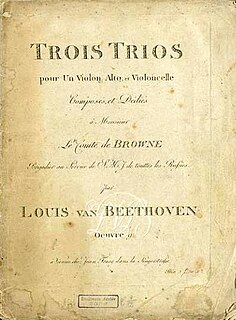
The term string quartet can refer to either a type of musical composition or a group of four people who play them. Many composers from the mid-18th century onwards wrote string quartets. The associated musical ensemble consists of two violinists, a violist, and a cellist.

Sir Arthur Edward Drummond Bliss was an English composer and conductor.

Carl Wilhelm Eugen Stenhammar was a Swedish composer, conductor and pianist.

Sir Peter Maxwell Davies was an English composer and conductor, who in 2004 was made Master of the Queen's Music.

Edward Elgar's Cello Concerto in E minor, Op. 85, his last notable work, is a cornerstone of the solo cello repertoire. Elgar composed it in the aftermath of the First World War, when his music had already gone out of fashion with the concert-going public. In contrast with Elgar's earlier Violin Concerto, which is lyrical and passionate, the Cello Concerto is for the most part contemplative and elegiac.

Franz Schubert's final chamber work, the String Quintet in C major is sometimes called the "Cello Quintet" because it is scored for a standard string quartet plus an extra cello instead of the extra viola which is more usual in conventional string quintets. It was composed in 1828 and completed just two months before the composer's death. The first public performance of the piece did not occur until 1850, and publication occurred three years later in 1853. Schubert's only full-fledged string quintet, it has been praised as "sublime" or "extraordinary" and as possessing "bottomless pathos," and is generally regarded as Schubert's finest chamber work as well as one of the greatest compositions in all chamber music.

Sir Edward Elgar's Introduction and Allegro for Strings, Op. 47, was composed in 1905 for performance in an all-Elgar concert by the newly formed London Symphony Orchestra. Scored for string quartet and string orchestra, Elgar composed it to show off the players' virtuosity. Though initial critical reception was lukewarm at best, the score soon came to be recognized as a masterpiece. The work, which is roughly twelve to fourteen minutes in length, is like a multi-layered symphonic poem for string orchestra, with several prominent themes.
The Quintet in A minor for Piano and String Quartet, Op. 84 is a chamber work by Edward Elgar.

Albert Edward Sammons CBE was an English violinist, composer and later violin teacher. Almost self-taught on the violin, he had a wide repertoire as both chamber musician and soloist, although his reputation rests mainly on his association with British composers, especially Elgar. He made a number of recordings over 40 years, many of which have been re-issued on CD.
Antonín Dvořák wrote his String Quartet No. 10 in E♭ major, Op. 51 (B. 92), in 1879 at the request of Jean Becker, the leader of the Florentine Quartet. It is sometimes nicknamed the Slavonic Quartet. The quartet was dedicated to Jean Becker; it was first performed by the Joachim Quartet at a private chamber music evening on July 29, 1879, in Berlin. It was published by Simrock, Berlin, in 1879.
Antonín Dvořák finished the composition of his String Quartet No. 1 in A major, Op. 2, (B. 8), one of his earliest chamber works, in March 1862.
The Naxos Quartets are a series of ten string quartets by the English composer Peter Maxwell Davies.
The String Quartet in E minor, Op. 83, was one of three major chamber music works composed by Sir Edward Elgar in 1918. The others were the Violin Sonata in E minor, Op. 82, and the Piano Quintet in A minor, Op. 84. Along with the Cello Concerto in E minor, Op. 85 of 1919, these were to be his last major works prior to his death in 1934.
Johannes Brahms's String Quartet No. 1 in C minor and String Quartet No. 2 in A minor were completed in Tutzing, Bavaria, during the summer of 1873, and published together that autumn as Op. 51. They are dedicated to his friend Theodor Billroth. He only published one other string quartet, No.3 in B-flat Major, in 1875.
Edvard Grieg's String Quartet No. 1 in G minor, Op. 27, is the second of three string quartets written by the composer. The first, in D minor, was an early work, now lost, written in the early 1860s at the request of his teacher, Carl Reinecke. The third quartet, in F major, remained incomplete at the composer's death.
The Quartet Movement in F major, B. 120, is the first movement of a planned string quartet in F major by Antonín Dvořák composed in early October 1881 to fulfill a commission from the Hellmesberger Quartet and abandoned in favour of the String Quartet No. 11 in C major, Op. 61, B. 121.

The three String Trios, Op. 9 were composed by Ludwig van Beethoven in 1797–98. He published them in Vienna in 1799, with a dedication to his patron Count Johann Georg von Browne (1767–1827). They were first performed by the violinist Ignaz Schuppanzigh with two colleagues from his string quartet. According to the violinist and conductor Angus Watson, these were probably Franz Weiss on viola and either Nikolaus Kraft or his father Anton on cello. Each of the trios consists of four movements:
The Adagio and Rondo Concertante in F major for piano quartet, D 487, was composed by Franz Schubert in 1816. A "brilliant" work designed as a display piece for the piano soloist, it is not only one of the few works the composer wrote in this style, but it is his first complete composition for piano and string ensemble, preceding the "Trout" Quintet" by three years.

String Quartet No. 2 in C major, Op. 36, by English composer Benjamin Britten, was written in 1945. It was composed in Snape, Suffolk and London, and completed on 14 October. The first performance was by the Zorian Quartet in the Wigmore Hall, London on 21 November 1945, in a concert to mark the exact 250th anniversary of the death of English composer Henry Purcell (1659–95). The work was commissioned by and is dedicated to Mary Behrend, a patron of the arts; Britten donated most of his fee towards famine relief in India.

String Quartet No. 1 in D major, Op. 25, by English composer Benjamin Britten, was written in the U.S. in 1941.










